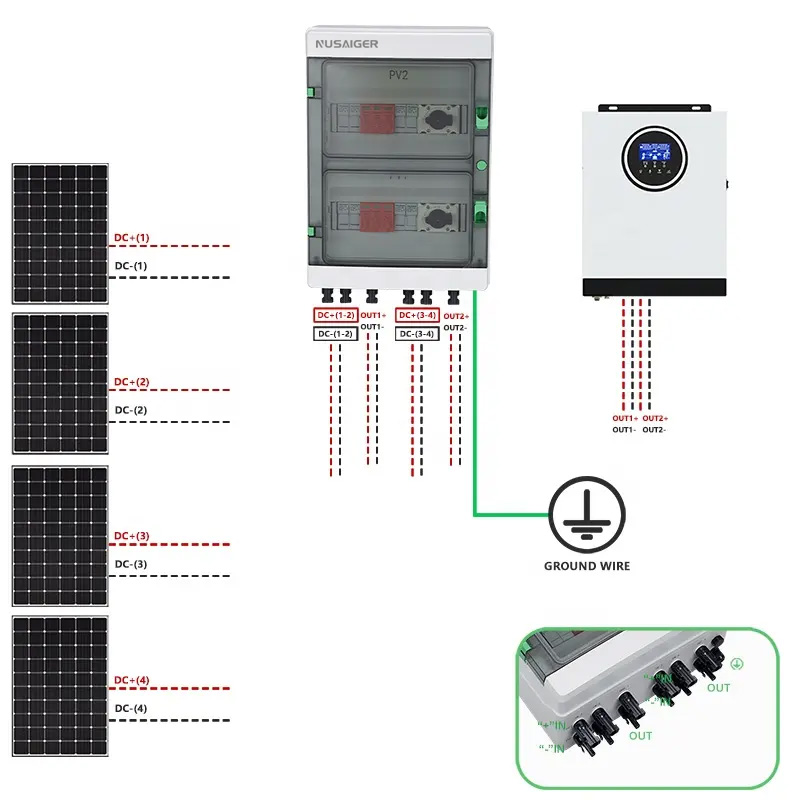Smart PV Combiner Boxes and the Role of IoT in Solar Monitoring
How intelligent combiner boxes transform solar system monitoring and enhance operational efficiency.
1. Introduction
Traditional PV combiner boxes play a passive role by simply consolidating string outputs and providing
basic protection through fuses and surge protective devices (SPDs). However, with the increasing
scale of solar plants and the demand for higher efficiency, there is a shift towards
smart PV combiner boxes equipped with IoT technology.
These intelligent devices offer real-time monitoring, fault detection, and predictive maintenance capabilities,
making them essential for modern solar projects. In this article, we explore how IoT is revolutionizing
combiner boxes and why smart designs are the future of PV systems.
2. What is a Smart PV Combiner Box?
A smart PV combiner box is an advanced version of the traditional box, integrating sensors,
communication modules, and control systems. Instead of being a passive junction point,
it acts as an active monitoring and diagnostic tool.
- Data Collection: Voltage, current, temperature, and insulation resistance monitoring.
- Communication: RS485, Modbus, Ethernet, or wireless connectivity.
- Intelligence: Fault detection, string-level monitoring, and remote shutdown capabilities.
3. Role of IoT in Smart Combiner Boxes
IoT technology enables data exchange between the combiner box and central monitoring platforms.
This connectivity allows operators to monitor system health in real time and take corrective actions remotely.
- Real-Time Monitoring: Continuous updates on string performance and protective devices.
- Predictive Maintenance: Using machine learning to predict failures before they occur.
- Remote Management: Adjusting settings, performing diagnostics, and triggering shutdowns.
- Data Analytics: Cloud-based platforms process large volumes of data for insights.
4. Key Features of Smart PV Combiner Boxes
- String-level current and voltage measurement.
- SPD status monitoring (end-of-life alerts).
- Fuse blow detection and alarm systems.
- Temperature and humidity sensors for environmental monitoring.
- Arc-fault detection and interruption (AFDI).
- Integrated communication gateways (4G, Wi-Fi, or LoRaWAN).
5. Benefits of Smart Combiner Boxes
Smart PV combiner boxes provide measurable benefits to solar developers, operators, and investors:
- Higher Energy Yield: Early fault detection minimizes downtime.
- Reduced O&M Costs: Remote diagnostics reduce site visits.
- Improved Safety: Arc-fault detection prevents fires.
- Better ROI: Increased reliability translates to long-term profitability.
- Scalability: IoT platforms can manage hundreds of combiner boxes across utility-scale plants.
6. Applications in Solar Projects
6.1 Utility-Scale Solar Farms
Utility projects with thousands of strings benefit from centralized monitoring, allowing operators
to quickly isolate underperforming arrays and reduce energy losses.
6.2 Commercial Rooftop Systems
Smart boxes help building owners track system output in real time and optimize energy consumption.
6.3 Microgrids and Off-Grid Systems
Remote monitoring via IoT is critical in off-grid installations where site access is limited.
7. Communication Protocols
Smart combiner boxes typically support multiple communication options for compatibility:
- RS485/Modbus: Widely used in industrial applications.
- Ethernet: High-speed connectivity for large plants.
- 4G/5G Cellular: Suitable for remote locations.
- LoRaWAN: Low-power wide-area network for long-distance monitoring.
8. Integration with SCADA and Cloud Platforms
Smart combiner boxes are often integrated with SCADA systems and cloud platforms,
providing detailed dashboards, alarms, and performance analytics accessible from anywhere.
- Cloud-based monitoring portals.
- Automated fault reports via email/SMS.
- Integration with asset management software for predictive analytics.
9. Case Studies
Case Study 1: Utility Solar in India
A 200 MW solar plant adopted smart combiner boxes with IoT monitoring.
O&M teams reduced site visits by 30% while maintaining high availability.
Case Study 2: Remote Microgrid in Africa
Smart boxes allowed remote monitoring of string-level faults, avoiding costly trips
to a remote desert site and ensuring uninterrupted power for local communities.
Case Study 3: Commercial Rooftop in Germany
Building owners used smart combiner box data to optimize self-consumption, reducing
reliance on grid electricity by 25%.
10. Challenges and Considerations
- Cybersecurity Risks: IoT connectivity requires robust encryption and authentication.
- Cost: Higher initial investment compared to traditional combiner boxes.
- Standardization: Lack of universal standards for smart features.
- Training: O&M teams need technical training to handle new systems.
11. Future Trends
- Integration of artificial intelligence (AI) for autonomous fault detection.
- Edge computing within combiner boxes to process data locally.
- Blockchain for secure energy data management.
- 5G-enabled ultra-low latency monitoring.
12. Conclusion
Smart PV combiner boxes are more than protective enclosures—they are the backbone of
intelligent solar monitoring systems. By leveraging IoT technology, these devices enable
real-time monitoring, predictive maintenance, and improved system safety.
As solar capacity continues to grow globally, adopting smart combiner boxes will
become an industry standard, ensuring efficiency and long-term reliability.



